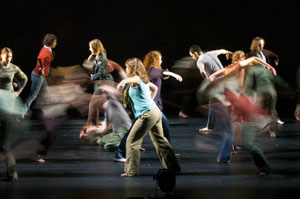4.) ART MAKING Development of underground

underground was inspired in part by a recent documentary by Sam Greene and Bill Seigel on the Weather Underground, a radical and sometimes violent leftist group active in the late 1960’s and early 1970’s. Although choreographer David Dorfman was too young to personally be involved in the anti-war, anti-establishment youth movements of this time period, he regards that period as part of his personal and cultural history. He writes: “Looking back at the 60’s and how it was the core of my emotional and artistic formation will be my entry point into this exploration – in essence, a return to my own ‘movement’ roots.” Indeed, his movement vocabulary for this dance tries to capture something of that time period, connecting physical movement to the idea of political movements.
While the title of the piece refers to the specific political activities of the Weather Underground, Dorfman’s choreography in underground really takes up the investigation of the personal as political, asking the audience to reflect on their own responsibilities in the midst of today’s turbulent world. His dancers move and talk, weaving their answers to the questions of political activity (how far would you go to resist the government?) and personal apathy (why would I care?) into responsive movement phrases. At times, they just mull around, with no particular direction or desire to do anything. At other times, they zip into high gear, zooming around the stage with bombastic movements. Relating how physical energy translates into political action (or not) is one of the central themes in the dance.
For the creation of this evening-length dance, David Dorfman collaborated with composer Joathan Bepler, videographer, Jacob Pinholster, scenic designer Cameron Anderson, and with Alex Timbers as his co-director and dramaturge. In addition, Jane Cox provided the lighting design and Heather McArdle did the costumes.
Classroom Activity: From Idea to Stage
Have the students return to their earlier brainstorming of what theme they would address as choreographers and have them discuss what music and costumes they would choose for their piece. Discuss how these aspects of the total production effect how the audience perceives the dancing (i.e. the difference between watching movement done in everyday clothes, versus fancy ballet costumes, etc.).

